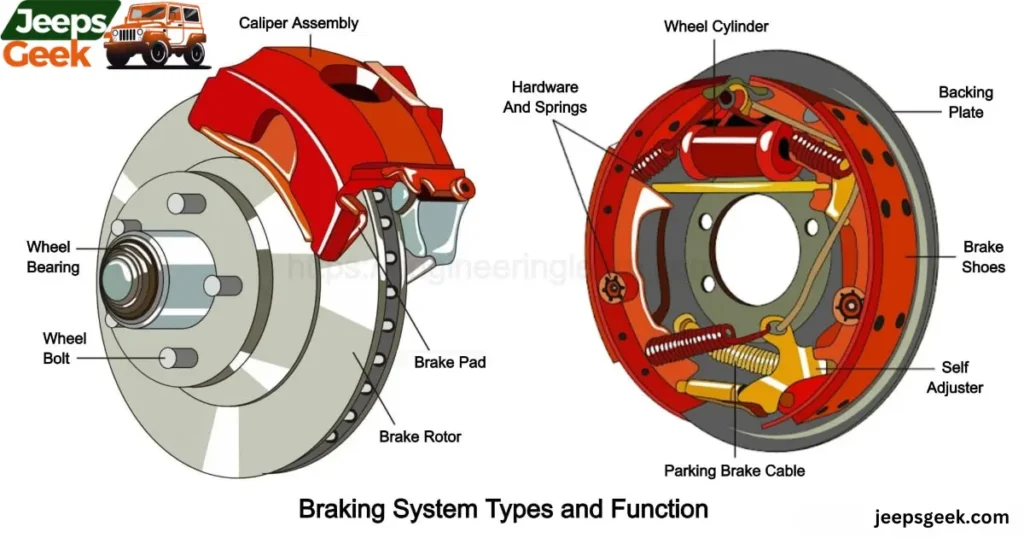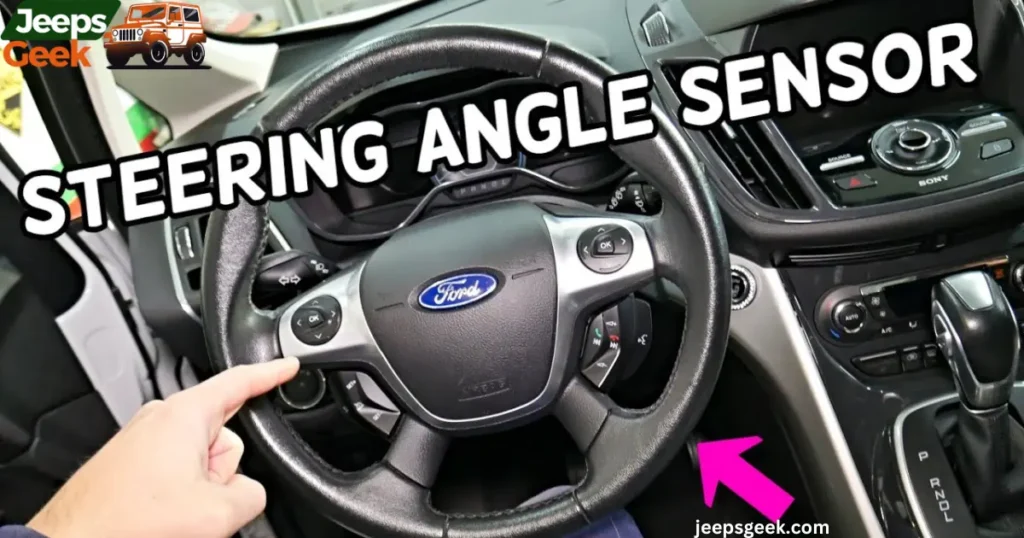Jeep’s electronic stability control is great for helping you steer your Jeep smoothly on the road. It uses the steering wheel and automatic brakes to keep your Jeep under control, especially during tricky manoeuvres.
However, sometimes it can have issues, leading to a warning message about the stability control system. This warning could be due to a sensor problem, loose wires, leaks, a problem with the brakes, an uneven steering wheel, a faulty vacuum pump, or a bad relay.
Keep reading to learn more about the stability control warning, what might be causing it, and how to fix it.
How Does a Jeep’s Electronic Stability Control Work?

The Electronic Stability Control (ESC) in your Jeep keeps an eye on how you’re steering and other things like how fast the wheels are turning. If you lose control of steering or traction, it steps in by reducing engine power or putting on the brakes to help you get back in control.
If you tweak the electronic stability control on your Jeep, it lowers the chances of it tipping over and helps to keep it safely on the road.
In a Jeep, there’s just one button for both the traction control system and electronic stability control (ESC). When you’re going fast, the electronic stability control kicks in, and at slower speeds, it’s the traction control that gets activated.
A Jeep’s Electronic Stability Control helps keep your ride steady. It uses sensors to detect if your Jeep is skidding or losing control. When this happens, it kicks in to brake individual wheels, helping you stay on course.
Think of it like a superhero for your Jeep, making sure you have a smooth and safe journey. So, when the road gets tricky, your Jeep’s Electronic Stability Control steps in to keep you in control and avoid any unexpected spins or slides.
What Does the Service Electronic Stability Control Jeep Warning Mean?
The warning light for the Jeep’s electronic stability control service usually shows up when your vehicle is not in control or when there’s a problem with the system. It might also stay on if someone manually turns off the system.
Many Jeep Grand Cherokee owners often encounter issues with the service electronic stability control. This warning light could illuminate for various reasons. It tells you if the computer senses slippery roads and your Jeep is not handling well.
Sometimes, your power steering might not work, and the electronic stability control warning light for the Jeep service may be on. If this happens, it’s crucial to park your Jeep immediately because a serious problem might be present.
Common problems arise when your fluid levels are too low or if there’s a leak. If the fluid levels are low, fill them up and start your Jeep to check for any issues.
If your fluid levels are okay, a loose fuse could be causing your power steering trouble. You can inspect the fuses to make sure they’re properly in place and also check your PCM, as these are common and easy fixes for power steering problems.
The Service Electronic Stability Control Jeep warning means that there’s a problem with the stability control system in your Jeep. This system helps keep your vehicle stable and in control, especially during challenging driving conditions.
When you see this warning, it’s like your Jeep’s way of telling you that something needs attention to make sure it stays safe and steady on the road. It’s a good idea to have it checked out by a mechanic to find and fix the issue, ensuring your Jeep stays reliable and secure during your journeys.
Read also: Troubleshooting Jeep Backup Camera Black Screen
What Causes the Service Electronic Stability Control Jeep Warning to Come on?

The computer system in your Jeep is connected to both the brakes and the anti-lock braking system. If your Jeep’s stability control is acting up, check the brakes and steering first.
Some Jeep owners get a warning about the stability control if there are issues with the brakes, main and backup batteries, vacuum pump, or vacuum sensors.
If your Jeep shows the service electronic stability control warning, it’s likely because there’s a problem with the system that helps keep your car stable. This warning could come on if there’s a sensor issue, a problem with the stability control module, or even due to a malfunction in the anti-lock braking system. It’s important to have it checked by a mechanic to make sure your Jeep stays safe on the road.
Sometimes, simple things like a loose gas cap or low battery voltage can trigger the warning. Checking these first might save you a trip to the service center. However, if the warning persists, it’s best to get a professional inspection to identify and fix the specific issue causing the electronic stability control warning in your Jeep.
1. Failing Wheel Sensors
Your car has special sensors on each wheel. They tell the Jeep’s electronic stability control system if the wheels are slipping. But if these sensors get dirty, they can’t work properly. This can make the ABS and Jeep electronic stability control systems not work right. When this happens, a warning saying “service electronic stability control Jeep” will show up.
If your wheel sensors fail, it means they can’t communicate properly with your car’s computer. This can affect important things like anti-lock brakes and stability control. If you notice any warning lights related to your wheels, it’s a good idea to have the sensors checked to keep your ride safe.
2. Steering Wheel Off Balance
After you lift your car, there’s a good chance that your steering wheel won’t be straight. If this happens, your car’s computer might think something’s wrong and show a warning about the stability control in your Jeep.
But don’t worry, it’s usually just noticing that the steering wheel is in the wrong position. You can easily fix it by adjusting the drag link to center the steering wheel. Just take a short drive afterward, and the issue should be fixed.
If your steering wheel is loose for some reason, like a worn-out screw in the steering mechanism, it could become unbalanced. This might trigger the stability control warning in your Jeep.
Sometimes, if you upgrade your Jeep Grand Cherokee by adding a new front bumper and winch, the warning light might come on. Check to see if the steering wheel is off-center after the upgrade.
Also, if you put in a new rack without checking the alignment of the front end or other parts, that could be the cause of the problem.
If your steering wheel is not in the middle and you need to fix the way your car drives straight, your Jeep’s stability control warning might come on.
Make sure the steering wheel is tight so it doesn’t get loose over time. You can also adjust the drag link to help with this.
If your steering wheel feels off balance, it could be a sign that your car’s wheels need alignment. When the wheels are not properly aligned, it may affect how your steering wheel feels and handles. Getting a wheel alignment can fix this issue and make your driving experience smoother.
Read also: Is SiriusXM Guardian Worth It?
3. Vacuum Leaks/Bad ECS Hose
If there’s a loose hose in your Jeep Grand Cherokee, air might leak out, causing a warning light for the electronic stability control. Your Jeep will also experience a quick loss of air pressure. The warning lights will stay on until you fix the hose.
Sometimes the hose completely comes off, meaning it’s broken and needs replacing. Once you use a new hose kit, your Jeep will be back to normal.
Another issue could be a leak in the vacuum line. You can fix this by swapping out the old hose with a new one.
If you have a vacuum leak or a bad ECS hose, air might be sneaking into places it shouldn’t. This can mess with your car’s performance. Get it checked and fix it to keep your ride running smoothly.
4. Faulty Vacuum Pump
If you see a warning in your Jeep saying “Service electronic stability control,” it’s likely due to an issue with the vacuum pump. You’ll need to change the pump because a faulty one can make certain fuses blow. If that happens, replace those blown fuses. Once you’ve swapped out the pump and replaced any blown fuses, everything should be back to normal.
5. Braking System Issues

If there’s a problem with your Jeep Grand Cherokee’s anti-lock braking system, like a broken brake booster check valve, you might see a warning for electronic stability control service. High mileage and off-road driving can lead to issues like worn brake linings and dirt in the brake fluid, affecting your Jeep’s electronic stability control. Also, a faulty brake light switch can trigger the ESC light and a service warning on your instrument panel.
If you’re having braking system issues, it could mean your brakes need attention. It’s crucial to address this promptly for safe driving. Consult a mechanic to ensure your brakes are working properly.
6. Issues with the Wiring
The wires help the computer inside the car talk to the wheel sensors about how much traction there is. If these wires get hurt, connected the wrong way, or if a special fuse breaks, a warning message about the Jeep’s stability control might show up.
If a wire that connects to the ground or a lug nut is not tight enough, it can also make the warning show up. To fix this, clean and make sure it’s tight. Also, check behind the headlight on the passenger side for a ground wire that might not be tight.
Inspect the connectors, wires, and signals. Look at the voltage readings on the wires that go to the brake booster.
If there are issues with the wiring, it means there might be problems with the electrical connections in your device or system. This can lead to malfunctions or even a complete shutdown. It’s important to address wiring issues promptly to ensure everything works properly and safely.
7. A Malfunctioning Steering Angle Sensor

If the warning light for the Jeep Grand Cherokee’s stability control is always on, it might be because the steering angle sensor is damaged or not working properly. This sensor tells the car’s computer which way the steering wheel is turned and helps it figure out the car’s direction based on the wheel speeds.
Sometimes, the steering angle sensor needs to be adjusted so that it provides accurate values. You can do this by driving the car in a straight line for a while and then calibrating the sensor. It’s best to use precise gauges to make sure the sensor is aligned correctly.
To check if the calibration is right, look at the live data from the car’s computer while someone else drives straight. Make sure the steering angle value is around 0 or 360 degrees, and the wheel speeds should be the same.
Other sensors for ride height may need calibration. If calibrating these sensors solves the problem, that’s great. If not, check the car’s alignment, camber, and tracking, and recalibrate the sensors if needed.
If your steering angle sensor is acting up, it means the part that helps your car understand the direction you’re turning might not be working right. This can make your steering feel weird or less responsive. It’s important to get it checked by a mechanic to keep your driving safe and smooth.
read also: 6 Tips to Fix Service Park Assist System, Jeep Warning
8. The fuse is Not Seated Correctly
If the Jeep’s stability control warning shows up, it might be because the fuses aren’t pushed in correctly. When you start the car again, check that all the fuses are firmly in place.
If the fuse is not seated correctly, it means it’s not in its proper place. To fix it, make sure the fuse is pushed in securely. This helps your device or system work the way it should.
9. Miscellaneous Issues
- Make sure your throttle control is functioning properly if you’re having issues with the Jeep’s electronic stability control warning.
- Check if a malfunctioning power steering pump caused the electrical failure in your Jeep.
- If the PCV valve fails, re-clamp it to fix the problem.
Once you’ve fixed the problems, your Jeep’s computer needs to check the electronic stability control system. Drive your Jeep for at least 50-100 miles so the computer can see if the system is working well. After that, the warning about the stability control should go away on its own.
Miscellaneous issues refer to various small problems that can pop up unexpectedly. These could include minor glitches, errors, or malfunctions that don’t fit into a specific category. Dealing with miscellaneous issues often involves troubleshooting to identify and fix these small hiccups.
| Pros | Cons |
| Resolves stability control issues | May require multiple visits to the service center |
| Enhances overall driving safety | Possible inconvenience due to unexpected warning |
| Timely action prevents further damage | Potential expenses for diagnostics and repairs |
| Maintains optimal vehicle performance | Temporary loss of confidence in stability control system |
| Ensures a smoother and safer drive | Brief inconvenience during troubleshooting and repairs |
Future Scope
Advancements in the service of Electronic Stability Control in Jeep vehicles may include more efficient diagnostic tools and improved troubleshooting methods. Enhancements could focus on quicker resolution times for identified issues, ensuring smoother experiences for Jeep owners.
Additionally, ongoing developments may lead to even more user-friendly interfaces for addressing Electronic Stability Control concerns.
Answer To Key Questions
What does it mean when my Jeep says service electronic stability control?
It means there’s an issue with your Jeep’s stability control system that needs attention.
What does service electronic stability control mean?
It means there’s a problem with the electronic stability control system in your Jeep that requires service or fixing.
Can I drive with service electronic stability control?
It’s best not to drive with this warning on. Get it checked to ensure safe driving.
What does it mean if the electronic stability control light comes on?
It means there might be a problem with your Jeep’s stability control system. Check it out to avoid potential issues while driving.
Conclusion
The Jeep’s electronic stability control warning can be tricky. If you’re fortunate, the issue might get fixed on the first try. However, some people have had to go back to the service centre multiple times to figure out the problem.
If you notice the electronic stability control warning light staying on in your Jeep Grand Cherokee or if you see the service electronic stability control Jeep warning, go through the list of possible problems one by one.
By doing this, you’ll identify the main issue, and once you fix that, your Jeep should be back to normal.

I’m Dariel Campbell, your companion at “Jeeps Geek.” Whether you’re tackling challenging terrains or dealing with Jeep intricacies, I’m here to assist. Let’s navigate the Jeep universe together, resolving issues and celebrating the spirit of off-road exploration.












